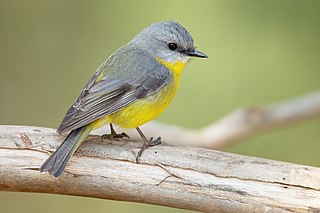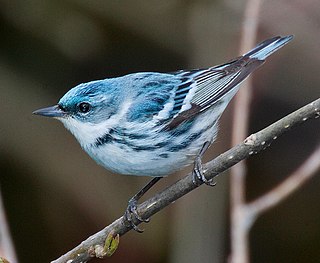
A songbird is a bird belonging to the suborder Passeri of the perching birds (Passeriformes). Another name that is sometimes seen as the scientific or vernacular name is Oscines, from Latin oscen, "songbird". The Passeriformes contains 5,000 or so species found all over the world, in which the vocal organ typically is developed in such a way as to produce a diverse and elaborate bird song.
Old World warblers are a large group of birds formerly grouped together in the bird family Sylviidae. They are not closely related to the New World warblers. The family held over 400 species in over 70 genera, and were the source of much taxonomic confusion. Two families were split out initially, the cisticolas into Cisticolidae and the kinglets into Regulidae. In the past ten years they have been the subject of much research and many species are now placed into other families, including the Acrocephalidae, Cettiidae, Phylloscopidae, and Megaluridae. In addition some species have been moved into existing families or have not yet had their placement fully resolved. A smaller number of warblers, together with some babblers formerly placed in the family Timaliidae and the parrotbills, are retained in a much smaller family Sylviidae.

Leaf warblers are small insectivorous passerine birds belonging to the genus Phylloscopus.

The golden-winged warbler is a New World warbler. It breeds in southeastern and south-central Canada and in the Appalachian Mountains in northeastern to north-central United States. The majority (~70%) of the global population breeds in Wisconsin, Minnesota, and Manitoba. Golden-winged warbler populations are slowly expanding northwards, but are generally declining across its range, most likely as a result of habitat loss and competition/interbreeding with the very closely related blue-winged warbler, Vermivora cyanoptera. Populations are now restricted to two regions: the Great Lakes and the Appalachian Mountains. The Appalachian population has declined 98% since the 1960s and is significantly imperiled. The U.S. Fish and Wildlife Service has been petitioned to list the species under the Endangered Species Act of 1973 and is currently reviewing all information after issuing a positive finding. Upon review, the U.S. Fish and Wildlife Service found that the petition to list the species as endangered or threatened presents "substantial scientific or commercial information indicating that listing the golden-winged warbler may be warranted."

The cerulean warbler is a small songbird in the family Parulidae. It is a long-distance migrant, breeding in eastern North American hardwood forests. In the non-breeding season, it winters on the eastern slope of the Andes in South America, preferring subtropical forests.

The Connecticut warbler is a small songbird of the New World warbler family.

Kirtland's warbler, also known in Michigan by the common name jack pine bird, or the jack pine warbler, is a small songbird of the New World warbler family (Parulidae). Nearly extinct just 50 years ago, populations have recovered due to the conservation efforts of Phil Huber and the U.S. Forest Service. It requires large areas, greater than 160 acres, of dense young jack pine for its breeding habitat. This habitat was historically created by wildfire, but today is created through the harvest of mature jack pine, and planting of jack pine seedlings.

Peleng is an island off the east coast of Sulawesi, Indonesia and is the largest island of the Banggai Islands. It is surrounded by the Banda Sea and Molucca Sea and has an area of 2,488.79 km2.

The elfin woods warbler is a species of bird endemic to Puerto Rico, where it is local and uncommon. Discovered in 1968 and described in 1972, it is the most recently described New World warbler.

The East Asian–Australasian Flyway is one of the world's great flyways of migratory birds. At its northernmost it stretches eastwards from the Taimyr Peninsula in Russia to Alaska. Its southern end encompasses Australia and New Zealand. Between these extremes the flyway covers much of eastern Asia, including China, Japan, Korea, South-East Asia and the western Pacific. The EAAF is home to over 50 million migratory water birds from over 250 different populations, including 32 globally threatened species and 19 near threatened species. It is especially important for the millions of migratory waders or shorebirds that breed in northern Asia and Alaska and spend the non-breeding season in South-East Asia and Australasia.

The Banggai crow is a member of the crow family from Banggai regency in the province of Central Sulawesi in Indonesia. It is listed as critically endangered by IUCN. It was feared extinct, but was finally rediscovered during surveys on Peleng Island off the southeast coast of Sulawesi by Indonesian ornithologist Mochamad Indrawan in 2007 and 2008.

The mountain leaf warbler is a songbird species from the leaf warbler family (Phylloscopidae). It was formerly included in the "Old World warbler" assemblage.

The Togian white-eye is a species of bird in the family Zosteropidae.

Moorea reed warbler is a species of songbird in the genus Acrocephalus. Formerly placed in the "Old World warbler" assemblage (Sylviidae), it is now in the newly recognized marsh warbler family Acrocephalidae. It was once considered a subspecies of the Tahiti reed warbler.

The Rote leaf warbler is a species of passerine bird in the family Phylloscopidae. It is endemic to Rote Island in Indonesia's Lesser Sunda Islands, where it lives in primary deciduous forest and secondary forest.
The Peleng fantail is a fantail endemic to the mountainous areas of Peleng island in Indonesia. It can be distinguished from other species of fantail by the black scaling below its black breast patch, bright white throat, and distinct courtship vocalization. It was described in 2020 alongside 9 other new species and subspecies of birds endemic to islands in Wallacea. All of them were discovered in surveys during 2009 and 2013, the largest discovery of its kind in over a century. It may be potentially threatened by deforestation and climate change-fueled wildfires.
The Taliabu leaf warbler is a species of Old World warbler in the family Phylloscopidae. It was first described in 2020 and was named after Prof Emil Salim, a former Minister of Environment of the Republic of Indonesia and eminent environmentalist. It is found in the undisturbed montane forest on Taliabu Island in Indonesia from 700m up to probably the highest elevations above 1,400m. The species may also occur on the large neighboring Mangole Island.
The Taliabu bush warbler is a species of Old World warbler in the family Locustellidae. It is endemic to the island regency of Taliabu in Indonesia.
The Taliabu myzomela is a species of bird in the honeyeater family. It was first described in 2020. The species was named after the village of Wahe on Taliabu Island, which is the gateway to the highest elevations on Taliabu where it most commonly occurs.













